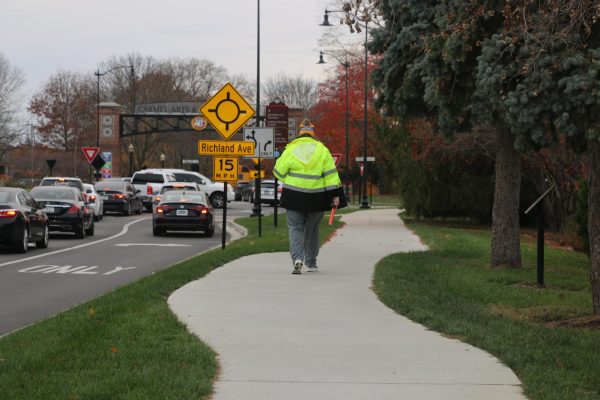 Laura Erli, Civil Engineering and Architecture teacher
Laura Erli, Civil Engineering and Architecture teacher
What is a Rectangular Rapid Flashing Beacon (RRFB)?
It is a lighted signal that creates a flashing, rectangular indicator that alerts drivers and other vehicles that there is a human crossing the crosswalk. It provides an additional visual cue that they need to be alert and aware of pedestrians. Sometimes, drivers can’t see the person if they’re wearing dark clothes that are not reflective. It just helps people get on high alert.
What is your reaction to the implementation of RRFBs?
They’re fairly new to me. After seeing these, I thought that they were a great idea. Sometimes the simplest thing doesn’t get thought of until way down the road. I’m just glad that they’re there.
Why do you think RRFBs were implemented now instead of before?
I think that they’ve had more time to do more studies to see if light signals used elsewhere have been more effective. That’s probably why they’ve finally decided to go ahead and invest in it. That and now more students are walking to school than we used to have them do before the bus shortage.
How are RRFBs different from other types of pedestrian traffic signals?
Those are intended for the pedestrians themselves to know when they should be safe to cross, assuming that all vehicles are obeying the traffic laws. These new signals are used at roundabouts where people don’t have a stoplight, so it’s a different traffic flow, a different traffic pattern.
Is it still helpful to have people direct traffic outside the school even with these new RRFBs?
At the high traffic times, yes. There is an excessive amount of traffic happening and they are stopping traffic not just to let pedestrians cross. Otherwise, the traffic would have the right of way most of the time. People who are in a rush and feel their rush is a priority over pedestrian safety would be a lot more dangerous, and traffic guards help keep everyone safe.
Would you consider Carmel to be a relatively safe place for drivers and pedestrians alike?
Due to all of the different things they implemented, it’s a very safe place. Time is taken to train new people as to what each of these new traffic signals on roundabouts do. They have explained that very well and they’ve implemented that into their new driver’s education curriculum better than locations that don’t have roundabouts. They’re a lot more diligent about pedestrian safety since they are encouraging more pedestrians and cycling traffic.
If time and money weren’t constraints, what infrastructure improvements do you think could be made to improve traffic safety in Carmel?
In my mind, I would advocate for specific bike lanes which are not sharing the road lanes with cars and traffic. Bicycles are definitely one of those things where all the walking pedestrians say that they belong on the road while all of the vehicle traffic says they should be on the sidewalks. They really do need their own lines to be safe for them where they’re not going to be in danger or hurting somebody or pushing someone out who is walking but they’re not going to be clipped by a car.
What would you consider to be the main purpose of transportation infrastructure?
I would think the main purpose of civil engineering is to create a more logical flow of people and improve the safety of both incoming and outgoing people. Even then, transportation infrastructure has so many different factors; it’s not just roads and bridges. I think our city focuses on these two principles very well.






















































![Review: “Suits” is a perfect blend of legal drama and humor [MUSE]](https://hilite.org/wp-content/uploads/2024/04/unnamed-1.png)
![Chelsea Meng on her Instagram-run bracelet shop [Biz Buzz]](https://hilite.org/wp-content/uploads/2024/04/IMG_2446-1200x838.jpg)
![Review: Quiet on Set: The Dark Side of Kids TV is the long awaited exposé of pedophilia within the children’s entertainment industry [MUSE]](https://hilite.org/wp-content/uploads/2024/04/unnamed.jpg)
![Review: “The Iron Claw” cannot get enough praise [MUSE]](https://hilite.org/wp-content/uploads/2024/04/unnamed.png)
![Review: “The Bear” sets an unbelievably high bar for future comedy shows [MUSE]](https://hilite.org/wp-content/uploads/2024/03/unnamed.png)
![Review in Print: Maripaz Villar brings a delightfully unique style to the world of WEBTOON [MUSE]](https://hilite.org/wp-content/uploads/2023/12/maripazcover-1200x960.jpg)
![Review: “The Sword of Kaigen” is a masterpiece [MUSE]](https://hilite.org/wp-content/uploads/2023/11/Screenshot-2023-11-26-201051.png)
![Review: Gateron Oil Kings, great linear switches, okay price [MUSE]](https://hilite.org/wp-content/uploads/2023/11/Screenshot-2023-11-26-200553.png)
![Review: “A Haunting in Venice” is a significant improvement from other Agatha Christie adaptations [MUSE]](https://hilite.org/wp-content/uploads/2023/11/e7ee2938a6d422669771bce6d8088521.jpg)
![Review: A Thanksgiving story from elementary school, still just as interesting [MUSE]](https://hilite.org/wp-content/uploads/2023/11/Screenshot-2023-11-26-195514-987x1200.png)
![Review: When I Fly Towards You, cute, uplifting youth drama [MUSE]](https://hilite.org/wp-content/uploads/2023/09/When-I-Fly-Towards-You-Chinese-drama.png)
![Postcards from Muse: Hawaii Travel Diary [MUSE]](https://hilite.org/wp-content/uploads/2023/09/My-project-1-1200x1200.jpg)
![Review: Ladybug & Cat Noir: The Movie, departure from original show [MUSE]](https://hilite.org/wp-content/uploads/2023/09/Ladybug__Cat_Noir_-_The_Movie_poster.jpg)
![Review in Print: Hidden Love is the cute, uplifting drama everyone needs [MUSE]](https://hilite.org/wp-content/uploads/2023/09/hiddenlovecover-e1693597208225-1030x1200.png)
![Review in Print: Heartstopper is the heartwarming queer romance we all need [MUSE]](https://hilite.org/wp-content/uploads/2023/08/museheartstoppercover-1200x654.png)























![Review: Ladybug & Cat Noir: The Movie, departure from original show [MUSE]](https://hilite.org/wp-content/uploads/2023/09/Ladybug__Cat_Noir_-_The_Movie_poster-221x300.jpg)

![Review: Next in Fashion season two survives changes, becomes a valuable pop culture artifact [MUSE]](https://hilite.org/wp-content/uploads/2023/03/Screen-Shot-2023-03-09-at-11.05.05-AM-300x214.png)
![Review: Is The Stormlight Archive worth it? [MUSE]](https://hilite.org/wp-content/uploads/2023/10/unnamed-1-184x300.png)


